Shrewsbury biscuits (aka Shrewsbury cakes) are a quick, easy and popular classic British bake that’s stood the test of time for centuries. Akin to thin shortbread and delicately flavoured with various optional additions these crisp and brittle biscuits are the perfect companion to a cup of tea.
Have you seen my recipe for soul cakes? It’s another gem from Shropshire also involving currants.
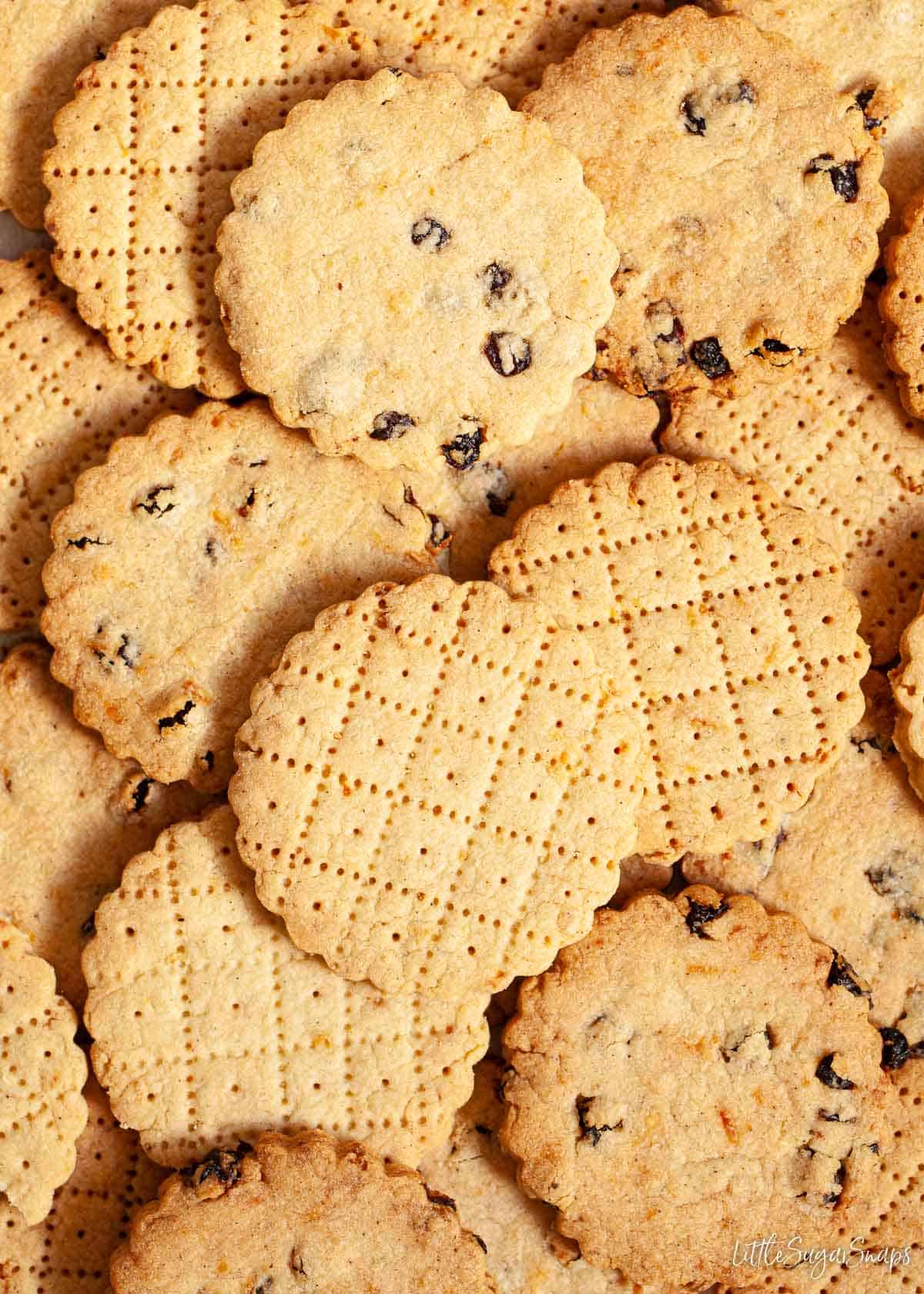
Want to Save This Recipe?
Jump to:
I not only have gorgeous Shewsbury biscuits to share with you today but also a wealth of information about this regional bake from Shropshire in the West Midlands.
Quite often when older recipes come to light it’s hard to identify clearly the heritage. But the Shrewsbury biscuit – in its many guises – has left a trail of crumbs for us to scoop up and take notice of. I’m presenting all that I’ve discovered here today along with my recipe.
This recipe for Shrewsbury biscuits (aka Shrewsbury cakes or even Shrewsbury cookies in certain places of the world) is part of my East and West Midlands recipe collection.

Why these biscuits are worth making
These classic British biscuits are worthwhile making for many reasons:
- And they stay fresh for over a week when stored properly.
- They are quick and easy to make.
- There’s no chilling of the dough required – they keep their shape well.
- They have a classic buttery taste with a hint of lemon.
- And these biscuits have great texture.
- The flavour can easily be adapted to suit personal taste preferences.
- There’s no need to decorate them (adding any icing would actually be a shame).
In the market for more crunchie biccies? Try your hand at my malted milk biscuits, lemon shortbread cookies or chai shortbread cookies. Alternatively, browse all my cookies & biscuits recipes for inspiration.
What is a Shrewsbury cake?
A Shrewsbury cake was the forerunning name of the Shrewsbury biscuit. Evidence suggests that they were incredibly similar bakes, perhaps with the cake being much larger than our modern-day biscuits.
The Shrewsbury biscuit that we know and love today has been repeatedly praised throughout history for its buttery taste and crisp, somewhat brittle texture. It’s like a very thin shortbread biscuit with a hint of lemony flavour.
Where and when did they originate?
This bake, originating from the town of Shrewsbury in Shropshire, has been around for centuries. It first appeared in a recipe book in 1658 (The Compleat Cook of 1658) but it’s likely these biscuits have been around since the 1500s.
Shrewsbury biscuits are often associated with a local Shrewsbury bookseller and baker called Mr Pailin. However, he did not create them. He was famed simply for selling them from his bakery. The site, close to Shrewsbury Castle, still exists and now bears a commemorative plaque noting 1760 as the year Mr Pailin started selling them there.
What flavours should be included?
The Compleat Cook of 1658 lists sugar, flour, eggs, butter, and lemon zest as ingredients but there are plenty of other old recipes knocking around featuring orange zest, rose water and various spices, particularly ginger, nutmeg and/ or cinnamon.
The general consensus seems to be that any combination of the above flavours goes. Caraway seeds and currants are also acceptable inclusions.
Why do they sometimes have a pattern?
Occasionally, these traditional biscuits come adorned with an ornate pattern. It’s quite an old-fashioned way to present Shrewsbury cakes, but they do look lovely when decorated this way.
The reason for the design is twofold:
- First of all, the dashed diamond pattern makes the biscuits easy to snap into bite-sized pieces. Back in the days when this bake would have been served to well-to-do ladies it made eating them in a refined, suitably lady-like fashion, possible. Ladies could snap a piece off and pop it into their mouths without having to do something so uncouth as taking a bite in public – oh, I say!
- Secondly, the holes in the centre of each diamond also help ensure an even and thorough bake. This helps achieve the crisp and brittle characteristics the Shrewsbury biscuit is famous for.
Luckily, the pattern is very easy to achieve. A fine-toothed comb (clean), a toothpick and a few minutes of patience are all that is required.
Links with India
This Shropshire speciality is famous outside of England too. Kayani Bakery, a family-owned business in Pune, near Mumbai, has been making eggless Shrewsbury biscuits for decades. Their version is similar to buttery shortbread without additional flavours such as lemon.
These biscuits proved hugely popular and, as a result, are quite famous. From what I gather they have fuelled many a teenage gossip-filled midnight feast at boarding schools over the years.
How should Shrewsbury be pronounced?
The correct pronunciation of Shrewsbury is hotly debated – especially amongst Salopians (people native to Shropshire). Some people say shrows (rhyming with throws) whilst others insist it’s definitely shroos (rhyming with brews).
Some claim the pronunciation comes down to how posh you are (go for shrows if you’re feeling posh today) whilst others assert it depends on whether you are English (shrows) or Welsh (shroos). This theory makes historical sense given the proximity of Shrewsbury to the Welsh border.
So how do I say it? Shroosbury – which discredits both theories as I’m neither posh nor Welsh. Still in two minds and feeling embarrassed? Take my advice: dodge the question entirely by munching a biscuit whenever anybody asks you what they’re called. It’s rude to talk with your mouth full, after all.
Ingredients notes

Nothing compares to butter when it comes to making Shrewsbury biscuits. It’s the rich, robust taste of butter that acts as the platform on which the rest of the flavour profile is built. For this reason, I don’t advise baking margarine.
The egg yolk serves to bind the ingredients together and provide additional richness to the biscuits.
Use only plain (all-purpose) flour in this recipe. As the name implies, self-raising flour contains a raising agent and is not suitable for making Shrewsbury cakes.
Lemon zest is mandatory for these biscuits in my opinion, but everything else is entirely optional. Play around and see what flavour combination you enjoy the most.
Keep in mind that rose water can vary in strength considerably from brand to brand. My recommendations are based on Nielson Massey rose water.
Equipment notes
If you intend to create the patterned Shrewsbury cakes then you will need a clean fine-toothed comb and a cocktail stick to do so. Combs are very cheap so I have one set aside just for baking purposes.
Step by step instructions
It’s possible to split the ingredients after step 2 to come up with 2 different versions of Shrewsbury biscuits. This is exactly what I’ve done in the photos below as I wanted to show the biscuits with currants but also without, to show off the pretty design.
- Begin by creaming the butter and sugar together using electric beaters.
- Then mix in the egg yolk and rosewater (if using).
- Sift the flour, salt and spices into the bowl. Add the grated lemon zest and the currants. Fold everything in using a metal spoon until the dough looks raggy.
- Use your hands to bring the dough together in a ball then knead briefly on a lightly floured worktop.
- Roll out to 3-4mm thickness and use a 6cm fluted cutter to stamp out the biscuits. Reroll the dough once to cut out a few more.
- Optional: decorate the biscuits using a comb and a cocktail pick:
- Simple press the comb across a biscuit about ¾cm from the edge. Don’t press all the way down – around halfway is fine.
- Repeat on the other side.
- Make 2 further indentations with the comb in between, leaving equal distances between each one.
- Turn the comb 90 degrees and repeat. You should end up with a diamond effect.
- Now use the cocktail pick to poke a hole into the centre of each diamond (push it all the way down).
- Lay onto baking sheets lined with parchment and bake in a preheated oven for 18-20 minutes.
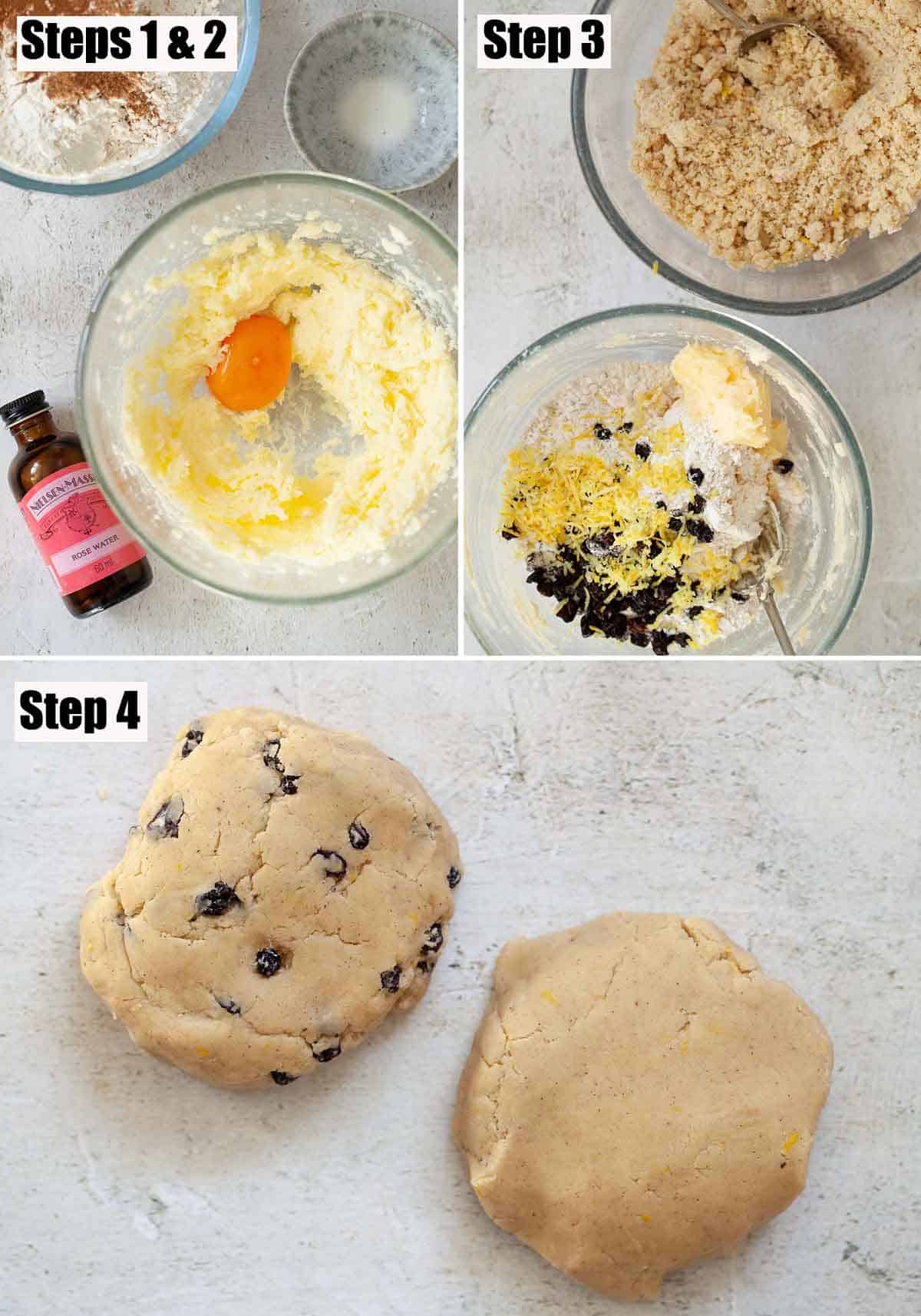

Expert tips
- Use a palette knife to move the biscuits to the baking sheet.
- Use softened butter as it is much easier to cream and will make mixing in the flour easier.
- Regardless, it will take a few minutes to work the flour into the creamed butter. This is normal.
- And it’s essential to get your hands into the bowl to bring the dough together.
- The dough should be quite firm and not sticky, so don’t be tempted to add milk or water.
- Need to make them gluten-free and/ or vegan? Try this recipe.
- Feel free to mess with the cutters – Shrewsbury biscuits are traditionally round but there’s nothing wrong with veering from tradition.
Frequently asked questions
Early recipes suggest 3 spoons of rosewater. Exactly how large those spoons were is open to debate. But one thing is for certain, modern-day rosewater is much more potent than the flavouring that bakers from centuries ago would have been using.
For this reason, my recipe includes just a hint of rosewater (¼ teaspoon). If however, you have a particular penchant for floral qualities in your cookies, this amount could be doubled.
Keep in mind that many people can find rosewater overpowering, so if unsure start with a smaller amount and work your way up on subsequent bakes until you reach your ideal level of floral pizazz.
That’s easy – a cup of tea. This partnership is so simple, yet so effective.
Aside from that, try serving them with fruity & creamy desserts, such as lemon posset or lemon mousse.
There are so many ways to use up that lingering egg white. Try whipping up some classic coconut macaroons or shake up a zesty cocktail. Alternatively, try your hand at homemade lemon sorbet (which these Shrewsbury cakes would also pair well with).
If kept in a reliable airtight container homemade Shrewsbury biscuits will stay crisp and brittle for at least a week. By far the best way I’ve found to store any biscuit or cookie is in a Kilner jar with a clip top lid. I no longer store biscuits in tins or Tupperware containers since discovering this trick.
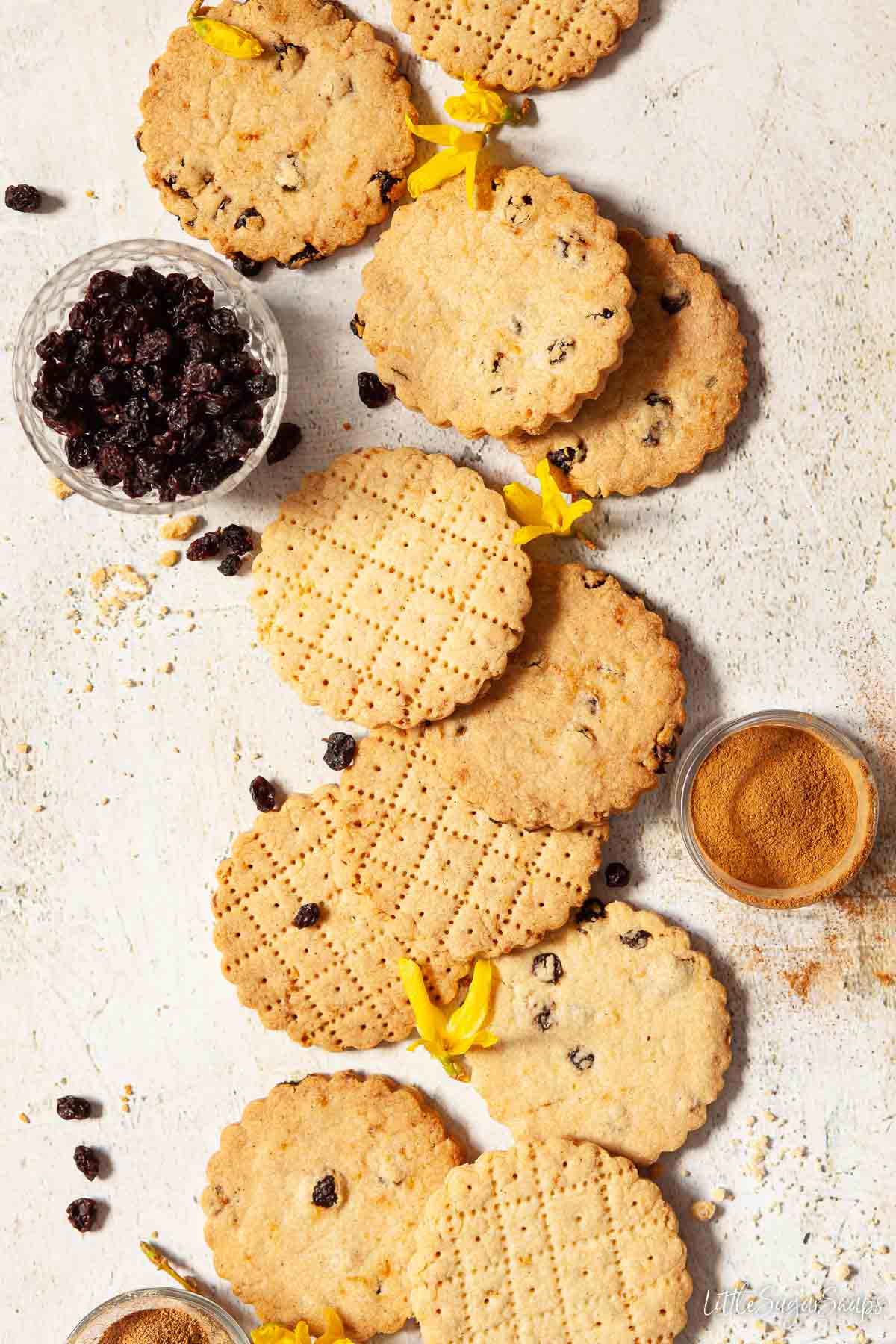
Shrewsbury cake variations
Fancy deviating from tradition slightly? Here are a few suggestions to ring the changes on your next batch of Shrewsbury cakes:
- Swap the lemon zest for orange zest.
- Use orange flower water in place of the rosewater.
- Play with the spices – try swapping the cinnamon for ginger.
- Add a few teaspoons of caraway seeds.
- Remove from the oven 5 minutes before the end of the cooking time, brush with egg white then sprinkle caster sugar on top and return to the oven for 5 more minutes.
Have you made these Shrewsbury biscuits? If so please let me know how you got along with the recipe by leaving a comment and/ or rating below. I always love to hear from my valued readers.
New here? Why not sign up to receive LittleSugarSnaps newsletters. You’ll hear first-hand when new recipes are published. You’re welcome to stay in touch on Facebook, Instagram and Pinterest too.
📖 Recipe
Want to Save This Recipe?
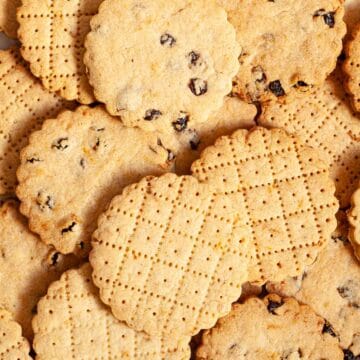
Shrewsbury Biscuits (Shrewsbury Cakes)
Equipment
- 1 Clean comb (fine-toothed)
- Baking sheets
Ingredients
- 200 g Plain flour all-purpose
- 100 g Butter soft
- 100 g Caster sugar
- 1 Egg yolk large, free-range
- Zest of a lemon finely grated
- ⅛ teaspoon Salt
- ¼ teaspoon Rose water optional
- ½ teaspoon Ground cinnamon optional
- ¼ teaspoon Ground nutmeg optional
- 50 g Currants optional
Instructions
- Preheat the oven to 140C/ 280F/ GM 1 and line two heavy baking sheets with baking parchment.
- Begin by creaming the butter and sugar together using electric beaters until light and fluffy.
- Beat in the rose water (if using) and the egg yolk.
- Sift the flour, salt and spices into the bowl. Add the grated lemon zest and the currants. Fold everything in using a metal spoon until the dough looks raggy.
- Use your hands to bring the dough together in a ball then knead briefly on a lightly floured worktop until it holds it's shape well.
- Roll out to 3-4mm thickness and use a 6cm fluted cutter to stamp out the biscuits. Reroll the dough once to cut out a few more.
- Optional: decorate the biscuits using a comb and a cocktail pick: (1) Press a clean fine-toothed comb across a biscuit about ¾cm from the edge. Don't press all the way down – around halfway is fine. (2) Repeat on the other side. (3) Make 2 further indentations with the comb in between, leaving equal distances between each one. (4) Turn the comb 90 degrees and repeat. You should end up with a diamond effect. (5) Now use the cocktail pick to poke a hole into the centre of each diamond (push it all the way down).
- Lay onto baking sheets lined with parchment and bake in a preheated oven for 18-20 minutes, rotating the trays after 10 minutes to ensure an even bake.
- Cook until just beginning to colour then let the biscuits cool on the trays for a few minutes before transferring to a wire rack to cool completely.
Notes
- Use softened butter as it is much easier to cream and will make mixing in the flour easier.
- Regardless, it will take a few minutes to work the flour into the creamed butter. This is normal.
- And it’s essential to get your hands into the bowl to bring the dough together.
- The dough should be quite firm and not sticky, so don’t be tempted to add milk or water.
- Need to make them gluten-free and/ or vegan? Try this recipe.
- Feel free to mess with the cutters – Shrewsbury biscuits are traditionally round but there’s nothing wrong with veering from tradition.
- Use a palette knife to move the biscuits to the baking sheet.
- If kept in a reliable airtight container homemade Shrewsbury biscuits will stay crisp and brittle for at least a week. By far the best way I’ve found to store any biscuit or cookie is in a Kilner jar with a clip top lid.

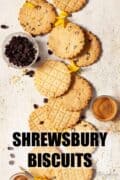




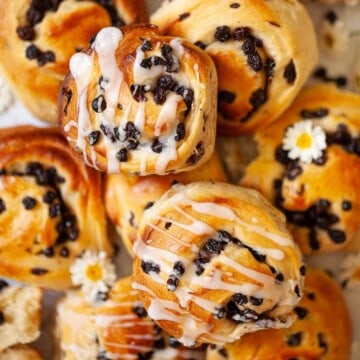




Marie D
100gm sugar divided by 20 cookies equals 5pm sugar each ☺️
Jane Coupland
Hi Marie, the nutritional information takes account of all ingredients. Sugar occurs naturally in dried fruit. I hope this clarifies why it’s not just a straightforward calculation.
Gillian
I made these delicious biscuits last night. 284F was just too low to brown them. I ended up leaving them in for an extra five minutes and turning up the heat to 350F in order to let them brown. I think a baking temperature of 300F would be better. Otherwise they turned out fine. Thanks for the recipe and the history behind them.
Jane Coupland
Hi Gillian, I’m so pleased that you enjoyed them and the information that I included in the post. By all means up the temperature a little as it’s quite possible that our oven temperatures vary slightly – leaving them in longer to brown them wouldn’t harm, just ensures that they are nice and crispy too.
Mel
Beautifully compiled recipe blog. Thoroughly enjoyed reading the trivia on the Shrewsbury biscuit.
Jane Coupland
Ah thanks Mel, that’s very kind of you to say so. These bicciesare part of a collection of recipes from The Midlands, all of which contain lots of background info, so be sure to take a look.
Jesse-Gabriel
Das Rezept ist perfekt und vielen vielen Dank für die Gramm Angaben!
Viele Grüße,
Jesse-Gabriel
Jane Saunders
Danke sehr!
trish
love the recipe but i am in usa cant do grams i will try to convert lol
Jane Saunders
I’m in the UK where grams and ounces rule. I always recommend grams as they are the most accurate measurement. If you’re open to trying grams then a set of digital scales ($15) would help you so much and make all recipes easy to follow regardless of where they are written. Also, if you can handle ounces then there’s a toggle button – press it and the conversion will appear.
Finally, there are a few guides around for converting grams to US cup measures such as this one: https://www.errenskitchen.com/cooking-conversions/cups-to-grams-and-oz/
Hope the above helps.